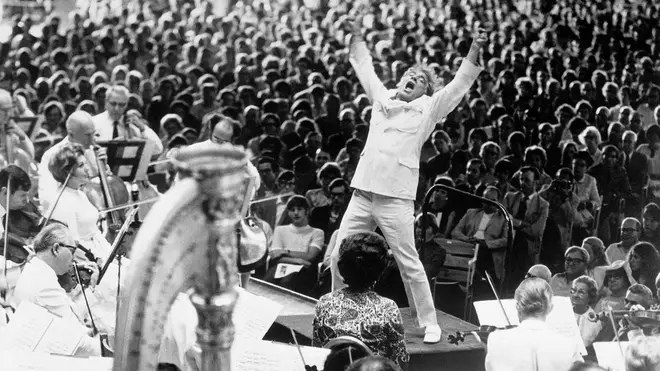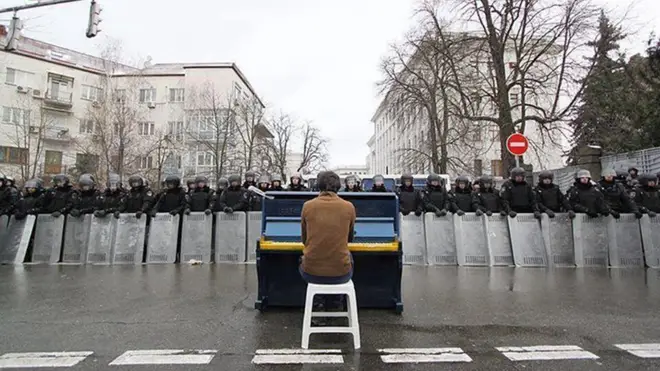On Air Now
Calm Classics with Myleene Klass 10pm - 1am
4 August 2023, 17:45

Classical music history’s most iconic photographs – from the haunting shots of the Cellist of Sarajevo, to Marian Anderson’s defiant performance at the Lincoln Memorial.
The power of music has found its place in the history books on more than one occasion – from the peaceful protests of musicians during wartime, to the pioneering instrumentalists and singers who fought to be heard on the concert stage.
While the history of classical music reaches back centuries, only the last 200 years have had the opportunity to be captured on film.
And so, here are 10 photographs of the most memorable moments from the history of this transformative and varied genre recorded in the flash of a camera.
Read more: 23 historic photographs of classical composers doing incredibly normal things

Dubbed ‘The Cellist of Sarajevo’, Bosnian musician Vedran Smailović became a famed face across the world as haunting images surfaced of him playing through the Siege of Sarajevo.
The Siege of Sarajevo was a six-year-long blockade of the capital city during the Bosnian War – the longest in modern war history, and over 13,900 people were killed, including over 5,000 civilians.
Smailović famously performed Tomaso Albinoni’s eerie Adagio in G minor on the bombed-out streets for twenty-two days in a call for peace. He also played for free at funerals during the siege, despite the fact they were often targeted by forces. The picture above shows him playing in the ruins of the National Library.
The cellist escaped Sarajevo in 1993, the second year of the siege, and now lives in Warrenpoint, Northern Ireland.

Born in 1897, Marian Anderson was a legendary African-American contralto and is famed for becoming the first Black singer to perform at the Metropolitan Opera in New York, in 1955.
But despite being one of the greatest singers of her generation, she was often faced with exclusion, and her performances protested against.
Anderson was once barred from a concert due to take place at the DAR Constitution Hall in Washington, D.C. in 1939. The Daughters of the American Revolution (DAR) had adopted a rule in 1932, during racial segregation, that refused performances from African-American musicians.
Eleanor Roosevelt, the wife of the sitting president, Franklin Delano Roosevelt, was a member of the organisation and resigned as she disagreed with their decision to refuse Anderson’s concert.
With the help of the President, Anderson was instead invited to perform on the steps of the Lincoln Memorial on Easter Sunday 1939. Over 75,000 audience members came to hear her sing, and millions more tuned into the live radio broadcast.
Read more: 11 black opera singers you should know about

This photograph has an incredibly powerful backstory.
In 2009, local music teacher Evandro João da Silva was mugged on the morning of Sunday 18 October while out with friends. He was fatally shot during this attack and his death rocked the AfroReggae community in Rio de Janeiro.
Da Silva had run a group called the AfroReggae Cultural Group which brought art, music and culture to some of the most deprived areas of Brazil’s second-largest city. He was a highly regarded music educator, and a number of young people who had experienced his work first-hand were traumatised by his death.
The photograph above was taken at Da Silva’s funeral. Pictured is a 12-year-old violinist who was playing at the funeral with a music ensemble created by the AfroReggae group. From the tears on his face and the evident emotion in his eyes, it is clear what a loss this death was for the community, and the lasting musical legacy da Silva left with these children.
Read more: The powerful story behind the viral photograph of a 12-year-old Brazilian violinist

Leonard Bernstein is remembered for an array of musical achievements; from writing West Side Story and an impressive collection of celebrated concert works, to becoming the first American conductor to achieve international acclaim.
Bernstein is also credited with bringing Mahler’s music into the mainstream.
Bernstein recorded all of the symphonies twice in what was called the Bernstein–Mahler cycle, and conducted all of the works in concert too. One of his most famous performances is where this iconic photograph comes from. Taken on 5 July 1970, Bernstein conducted Mahler’s 2nd, the Resurrection Symphony, at the Tanglewood Music Festival in Boston, nearly falling backwards from the emotion.
According to the conductor’s biographer, when Bernstein died, he was buried with a pocket score of Mahler’s Fifth Symphony. A testament to his lifelong love for the composer.

In December 2013, protestors in the Ukrainian capital of Kyiv brought down a statue of Vladimir Lenin. The monument was toppled as part of an attack on multiple Soviet statues during a period of civil unrest in Ukraine. Berkut riot police were called to respond to the protestors.
The day after the fall of the Lenin statue, an unnamed pianist set up his piano in front of a blockade of riot police and began to play a piece by Polish composer, Frédéric Chopin. The act is said to have been part of a ‘Warm Ocean Strategy’ – a movement which gained momentum in Ukraine at the time, to use peaceful forms of protest.
Photographed by Facebook user Anastasiia Bereza, the pianist also performed traditional Ukrainian and folk music, and a cover of Queen’s ‘We Are The Champions’.

Edward Elgar’s Cello Concerto is one of the most recognisable works from the history of classical music. An intimate exploration of the cello’s emotional depths, the piece’s popularity which came some 40 years after its composition, cemented Elgar’s concerto as the cornerstone of the instrument’s extensive repertoire.
Written after the end of the First World War in 1919, Elgar poured a flood of emotions into the work, resulting in his most unique composition to date. He recruited British cellist Beatrice Harrison to record the first abridged recording of the concerto in 1920. The recording, photographed above, was conducted by Elgar himself.
Harrison was a lifelong friend of English composer Frederick Delius, and premiered many of his works for the string instrument, which were often written for her. Whilst the Elgar concerto wasn’t written for her, she was asked to make the first complete recording of the work in 1928 and gave its first festival performance in 1921.

Born in 1867, Maud Powell was a violin virtuoso at a time when a solo instrumental career was frowned on for women. She is remembered as one of the first American violinists to achieve international acclaim and premiered multiple high-profile concertos for the instruments in the United States, including the Tchaikovsky, Sibelius, Bruch, and Samuel Coleridge-Taylor’s Concerto in G minor, which she commissioned.
During her lifetime, she was the greatest woman violinist in the world and championed music written by women, American and Black composers.
In 2014, Powell finally got the recognition she deserved almost a century after her death when she received a Grammy Lifetime Achievement Award for her exceptional career.

20th century composer and women’s rights campaigner Dame Ethel Mary Smyth DBE wrote brilliant symphonies, chamber music and operas, and was the first woman composer to be honoured with a damehood.
Smyth had a strong connection to the suffragette movement and personally knew the Pankhurst family, and is even credited with teaching Emmeline Pankhurst how to throw stones. Pankhurst presented Smyth with a baton in 1910 after the composer wrote an anthem for the Women’s Social and Political Union (WSPU), of which she was a member. The song titled The March of the Women became the widely adopted anthem for the UK suffrage movement and beyond.
Smyth served two months in Holloway Prison for throwing stones with a large group of suffragettes. According to conductor Thomas Beecham who came to visit the Smyth during her sentence, he found the composer leaning out of her window conducting a choir of suffragettes in a rendition of the WSPU anthem in the prison courtyard, with a toothbrush.
In the above photograph, Smyth was invited to conduct the Police Band in 1930 during the ceremonial unveiling of the Emmeline Pankhurst statue in Victoria Tower Gardens, two years after the activist’s death.

Rami Basisah was forced to flee his home country of Syria in 2015 after a civil war broke out. The 24-year-old was one of 378,000 refugees who left the country that year.
Basisah was studying at a music school in Homs when the war broke out. At least 70 percent of the city, which was home to a population of 1.5 million, was destroyed. The devastation led to a mass exodus of refugees, and most escaped to Greece via a perilous boat journey across the Mediterranean.
Before fleeing the city, Basisah wrapped his most treasured possession, his violin, in clingfilm and strapped it to his back. His journey took him 2,500 miles across eight countries, travelling only by foot and boat. Along his journey, he landed on the Greece-Macedonia border, where he was photographed by Jure Erzen playing his violin for others fleeing their own homes.
The young musician performed Beethoven’s Ode to Joy and Vivaldi’s Four Seasons and his impromptu concert inspired him to release a charity album two years later in 2017, raising money for the Red Cross. He made his Royal Albert Hall debut at Classic FM Live the same year, performing the emotive Schindler’s List theme by John Williams.

On 11 November 1989, two days after the fall of the Berlin Wall, legendary cellist Mstislav Rostropovich played an impromptu concert to soundtrack the reunification of a divided Europe.
Rostropovich was one of the greatest musicians of the 20th century. The Russian cellist and conductor had impeccable technique and premiered multiple notable works from high-profile composers such as Sergei Prokofiev and Dmitri Shostakovich.
The musician was also known as being a diligent advocate of human rights and in 1974 was presented with the Award of the International League of Human Rights.
The fall of the Berlin Wall was one of the most pivotal moments of the last century, and Rostropovich convinced his friend with a private jet, to fly the musician and his cellist out to Berlin soon after the world-changing event. This was due to the fact that commercial flights to the German capital were completely booked up as loved ones travelled to reunite with those who had been separated by the wall.
Two days after the fall, Rostropovich sat at Checkpoint Charlie, the wall’s famed crossing point by the Brandenburg Gate and began to play music by German composer, Johann Sebastian Bach.
The quiet act received the attention of the world’s press as Rostropovich welcomed those travelling from East Berlin into West. An emotive piece of musical history captured in the above black-and-white photograph.